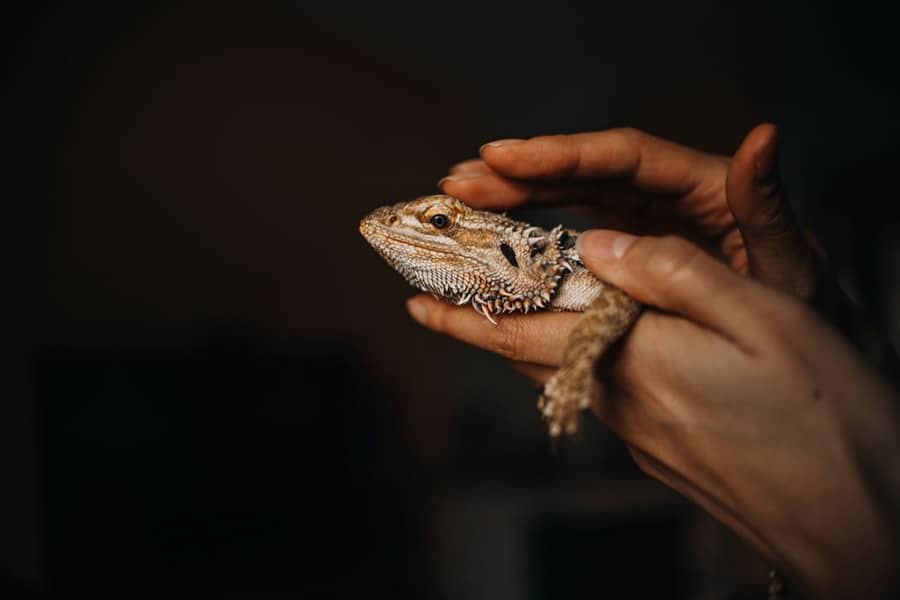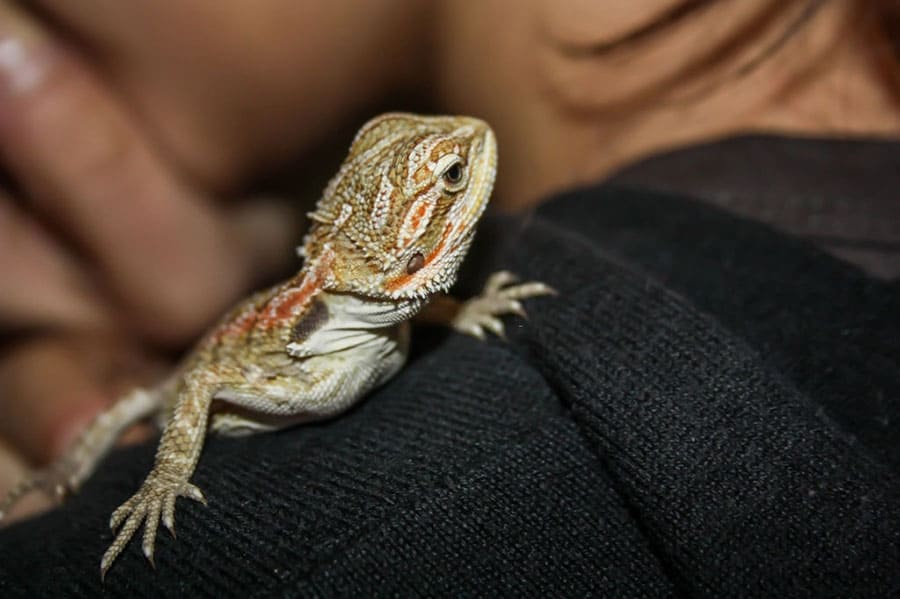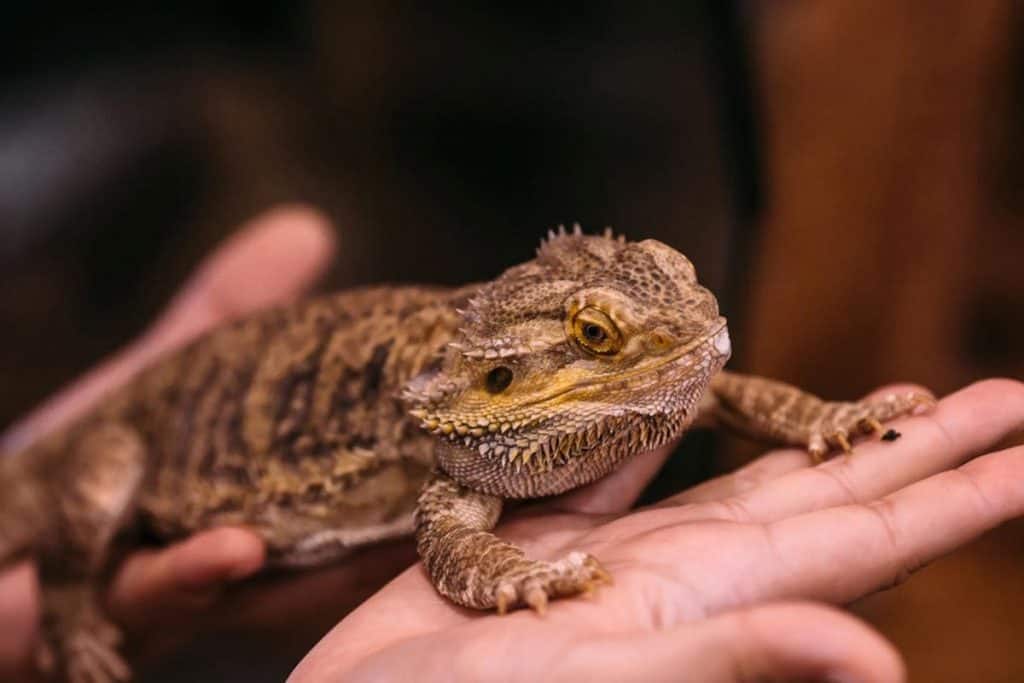Are bearded dragons good pets? That depends on the kind of pet you like. Although common pets like cats and dogs are quite popular, bearded dragons trump both of these fur babies because they have many of their benefits and far fewer flaws; for example, they don’t shed hair everywhere or make any noise!
Most pet parents adopt (or buy) their furry or scaly babies for friendship. Your pet keeps you company and brings out your nurturing side. But with daily life being so hectic, you may also want a pet that’s low-fuss and doesn’t need much attention. Cost matters, too.
Bearded dragons have an interesting yet adorable appearance. There’s also a fun sort of mystique to owning unusual pets like lizards. It helps that bearded dragons get along fairly well with other pets and won’t try to attack or eat them due to their docile, laid-back nature.
But how are bearded dragons as pets? If you haven’t had one before, you’re probably unsure of what to expect. Keep reading to learn the benefits of beardies (and their drawbacks, too). You’ll soon see they can be just as fulfilling as cats, dogs, rodents, and birds.
14 Reasons Why Bearded Dragons Are Good Pets
Why should you get a bearded dragon? Sure, they are among the most popular reptiles commonly kept as pets. But is a bearded dragon a good pet for you specifically? Here are some of their pros to consider:
Maybe you’ve tried a furry pet in the past and are ready for a change. Or maybe you saw a colorful beardie morph that made you long to take them home. Either way, here are 12 top reasons to get yourself a bearded buddy.
1. They’re Amazing Ice Breakers
As a pet parent, you may worry about bringing someone home and introducing them to your fur baby or scale baby. But bearded dragons are such good conversation starters, right from how they got their name! Plus, as your beardie warms up to your date or your guests, they will stop hiding and become increasingly responsive — they might even wave! Your friends will be so impressed!
https://youtu.be/t_jruHOECmM
2. They’re Easy to Take Care of
As long as you feed your beardie the right food and vitamins, give them proper lighting, and keep them hydrated, they don’t need much else. Misting with water daily and providing a bowl of clean, fresh water helps them stay hydrated without raising the humidity of their habitat.
They’re quiet too. Dogs bark often and mournfully beg for attention. Cats tear up the house – loudly – at 3.00 a.m. Beardies will usually just chill ang relax with their mouths open. They never make a sound unless they’re upset. And even then, they emit a low hiss that rarely travels past your reptile room. They’re great if you value a calm, quiet home.
3. They’re Less Likely to Trigger Allergies
If you keep furry pets, allergies are sometimes caused by pet dander. It’s not their fur itself – it’s the shed skin cells, saliva residue, or traces of urine that mix to form this ‘pet dust’. And beardies don’t have dander.
4. They Come in Pretty Colors
Many bearded dragon morphs, or color variations, make attractive pets. You’ll love showing them off to guests. Keep in mind, though, that while the cheapest bearded dragons are brown or tan, rare colored morphs can get expensive. Solid white morphs can cost over $1,000!
5. Their Immune Systems Are Strong
While your beardie does need to see a vet every year, they are hardy animals that don’t get sick often when cared for properly. Parasites are really only an issue if you don’t purchase insects for them from reputable sources, and when they have wounds or blood infections, they recover quickly.
This is because their renal portal circulation system cleans blood from their legs before sending it to the heart. Any limb or tail injury – which is common when they run around in the wild or in their enclosure – won’t easily spread infection to the rest of their body.
6. They Live a Long Time
Bearded dragons can live for 8 to 15 years! The oldest one on record died at 18. So, if you get your beardie as a baby at 6 to 10 weeks, you can grow together longer than most typical pets. They make a great first-time pet for teens, tweens, and even younger children who are mature enough to handle them with care.
7. They Shed Their Skin in Patches
Younger beardies shed around twice a month while they grow rapidly, while adults are closer to twice a year. And while other reptiles shed their skin in a single piece – a bit like taking a dress off – beardies do it in patches. This gives you more excuses to handle your bearded baby by bathing them and helping them loosen their old skin.
8. They ‘Smell’ with Their Tongues
When you take your beardie out of their cage or put them in a new place, they flick out their tongues to ‘sniff’ these new surroundings. It’s such a joy to watch! Just make sure your beardie is merely curious rather than stressed.
9. They Won’t Hurt You
Other pets often scratch or bite when they’re upset. Bearded dragons rarely bite and are very docile. If they’re upset enough to bite, they’ll give you lots of warning (plus, beardie bites are non-venomous). Their beard may puff up, they may hiss, or they may turn and run away.
10. They Can Live Anywhere and Don’t Need Much Space
Bearded dragons originally come from Australia. Their natural habitat is desert, semi-arid, or sub-tropical, depending on the species. But when you keep these pretty lizards as pets, they spend most of their time inside an enclosed glass tank. It’s easy to control the temperature, humidity, and light levels inside their
As long as you have a well-kept 55-gallon tank, your bearded dragon will be happy. While some people have dedicated reptile rooms, you can set up a simple enclosure at the corner of your bedroom. If you’re worried about the tank lights keeping you up at night, you can get a ceramic heat emitter instead.
11. They’re Friendly and Love to Cuddle
Most beardies are happy being handled by their owners. They can recognize you and will often scamper toward you if you call their name. They seem to enjoy being petted and will nap on your shoulder, neck, or lap for hours at a time.
If you want a pet you can handle and even cuddle with, a bearded dragon is your best bet. Bearded dragons will enjoy crawling up your arm and curling around your neck each time they get out of their tank. It’s probably because they want a better view of their surroundings and the warmth of your body heat, but you can still enjoy it!
12. They’re Affordable
The initial cost of getting a bearded dragon can be high – anything from $100 to $1,000. This covers buying the beardie, setting up their habitat, and visiting the vet. But every month, your beardie only costs $50 to $100 to feed. Pick wood or rocks from the yard and microwave them for décor.
You can even have more than one – but only if they’re girls around the same size. Bearded dragons are mostly solitary animals, but they can share their
13. They’re Diurnal Pets
They’re awake and active during the day and largely sleep through the night. So, unless you work the graveyard shift, your beardie will follow your daily routine. They do brumate in the winter, but even then, they will still wake up periodically for food and water. This isn’t a pet that will leave you feeling lonely.
Getting started with a bearded dragon isn’t hard. If these twelve reasons have convinced you, you could buy one at the pet store for under $100 and everything they need for an additional $200 or so. You could also adopt one from a pet rescue for a far lower fee. Get a younger dragon so you can enjoy them longer!
14. They Pee and Poo Simultaneously
Cats will sometimes spray hidden spaces when upset, and dogs pee everywhere to mark their territory. Both can be hard to find and clean. But because bearded dragons (like most other reptiles and birds) merge their toilet time, you can easily spot their messes and scoop them out or wipe them off the floor of their enclosure.
The Cons of Having Bearded Dragons as Pets
While bearded dragons have a lot going for them, there are some drawbacks you should keep in mind depending on your lifestyle and preferences.
1. They Need Live Food
That’s not necessarily a disadvantage, but if you’re a pet parent that gets squeamish watching your scale baby eat live bugs, you may struggle with this. Baby beardies need 80% bugs and 20% plant matter in their diets, while adults need 20% bugs and 80% plant matter. Feeding live bugs is best to promote exercise and provide enrichment.
2. Their Stool Smells Really Bad
As a pet parent, you expect to clean up after your scale baby. But beardie poop can knock you down! Plus, it carries the risk of salmonella poisoning. But even without the poop, beardies have a distinct scent that takes getting used to for some people.
3. Vet Bills Can Get Pricey
This is especially true for female bearded dragons. Females can become egg-bound, and they will need surgery to resolve this if it occurs. This is why many first-time beardie parents opt for male beardies instead.
4. They Need Very Specific Tank Conditions
Your beardie’s enclosure needs humidity levels of 20% to 40%, daytime temperatures of 85°F to 110°F, and nighttime temperatures of 70°F to 80°F. You may worry about getting this wrong and be nervous about harming your bearded dragon. But with the right equipment and proper lighting, you can easily maintain these settings. It helps if you install a thermostat and hygrometer as well to adjust the enclosure accordingly
As you can see, the cons of bearded dragons aren’t deal-breakers, as long as you’re willing to put in the necessary care and take on the responsibility of keeping such a pet.
FAQs About Bearded Dragons as Pets
Are some beardie breeds better pets than others?
Yes. Of the eight known bearded dragon species, only four are commonly kept as pets. These are Pogona vitticeps, Pogona henrylawsoni (aka Rankin’s Dragon), Pogona barbata, and Pogona bullarbor. The other four species are rarely bred and are difficult to tame.
Can bearded dragons be potty trained?
Yes, but they really don’t require any training. Pet parents often struggle with litter and pet smells. Beardies don’t have this problem because they prefer to do their business in the same spot.
Can I take my pet bearded dragon outside?
Yes, you can and should from time to time! Their bodies benefit from direct sunlight, so you can take your scale baby into the yard for 30 minutes to an hour or more if it’s warm enough outside.
However, unlike cats and dogs, bearded dragons can’t find their way back into the house. Never leave them outside unsupervised, and use a proper harness for their walks so they don’t get spooked and run away.
Can I travel with my bearded dragon?
Yes, you can, as long as you don’t let them get too cold on long-distance drives. Your scale baby will stay calm as long as you’re nearby, so get them a see-through travel box. This could be a smaller 10-gallon
Is it a lot of work to keep your bearded dragon clean?
No, it’s not. Washing a bearded dragon isn’t as difficult as bathing a cat or dog. Your beardie won’t fight the bath – they actually enjoy it because it helps them hydrate and shed. And you don’t even need soap – just a tub of shallow water and maybe a shedding product. You should bathe them around once a week.
All Said and Done, Are Bearded Dragons Good Pets?
Yes, bearded dragons make good pets. Unlike some fur babies that sleep all day, beardies will run around the cage exploring and chasing live prey. You’ll never get bored watching them! Also, when you take them out of their
But remember, to keep your bearded dragon happy, always ensure they have optimal conditions. Things to keep in mind include:
- Careful observation of their behavior so you can catch any issues early
- Regular vet visits to ensure good health and a long life
- Routine maintenance, e.g. changing the UVB bulb twice a year
- Picking the right substrate (avoid loose substrates, as they can cause impaction)
- Feeding your beardie the right food and vitamin supplements
If you take the time to bond with your bearded dragon, they will reward you with their loyal companionship. Plus, once the tank is set up, they don’t need much care or attention. Their affectionate nature and relatively simple care requirements make them the ideal pet.




